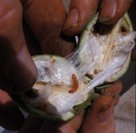Biotech cotton: Less spray but same yield
Arizona farmers who grow genetically modified cotton can skip some of their usual insecticide spraying. Those crops have the same impact on crawling insects and the same yield as unmodified cotton does, according to a field study.

Yves Carrière of the University of Arizona in Tucson and his colleagues monitored 21 commercial fields of so-called Bt cotton, which carries genes from the Bacillus thuringiensis bacterium. Bt cotton makes a bacterial toxin that tends to kill moths and butterflies. Arizona cotton growers count on this biotech variety to knock out pink bollworms.
Researchers also studied 20 fields of cotton genetically engineered to produce the bacterial toxin and also to resist the weed killer glyphosate. Forty other fields grew cotton with no engineered genes.
The fields of the two types of transgenic cotton fields required insecticide spraying less often than traditional cotton fields—3.1 versus 6.6 times the first year, and 4.9 versus 6.8 times the next year. However, the crop yields from all the fields were about the same, the researchers say.
The researchers also sampled uncultivated adjacent land and the fields themselves for some of the insects that don’t threaten crops. Ant populations declined regardless of the kind of cotton. However, the cotton fields hosted more beetles than the uncultivated areas did. The effects on ants and beetles didn’t vary with the type of cotton planted, the researchers say in the May 16 Proceedings of the National Academy of Sciences.
Carrière concludes that in Arizona, at least, transgenic cotton is easing the environmental costs of intense agriculture. However, he says, “you have to be careful and take each system on a case-by-case basis.”






